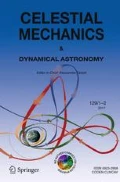Abstract
We are dealing with the averaged model used to study the secular effects in the motion of a body of the negligible mass in the context of a spatial restricted elliptic three-body problem. It admits a two-parameter family of equilibria (stationary solutions) corresponding to the motion of the third body in the plane of primaries motion, so that the apse line of the orbit of this body is aligned with the apse lines of the primaries’ orbits. The aim of our investigation is to analyse the stability of these equilibria. We show that they are stable in the linear approximation. The Arnold–Moser stability theorem provides sufficient conditions under which this means stability in a nonlinear sense too. These conditions are violated for parameters of the problem that belong to a set formed by a finite number of analytic curves in the parameters’ plane. As it turned out, in the system under consideration, violation of these conditions in some cases actually leads to an instability.











Similar content being viewed by others
Notes
Roughly, the equilibria of the averaged problem correspond to lower-dimensional invariant tori in the phase space of the unaveraged problem. In reality, the existence of these tori depends on the ratio of the frequencies of the motions over which the averaging is performed, and on smallness of the perturbation. Rigorous investigation of lower-dimensional tori is a special topic in KAM theory (see, e.g. Arnold et al. 2006, section 6.3.7).
Additionally to Sokolskii (1974), we consider the case of an approximate (not exact) resonance, and dynamics on the energy levels that do not contain the considered equilibrium.
References
Aksenov, E.P.: The doubly averaged, elliptical, restricted, three-body problem. Sov. Astron. 23, 236–240 (1979)
Arnold, V.I.: The stability of the equilibrium position of a Hamiltonian system of ordinary differential equations in the general elliptic case. Sov. Math. Dokl. 2, 247–249 (1961)
Arnold, V.I., Kozlov, V.V., Neishtadt, A.I.: Mathematical Aspects of Classical and Celestial Mechanics, 3rd edn. Springer, New York (2006)
Brouwer, D., Clemence, G.M.: Methods of Celestial Mechanics. Academic Press, New York (1961)
Harrington, R.S.: Dynamical evolution of triple stars. Astron. J. 73, 190–194 (1968)
Katz, B., Dong, S., Malhotra, R.: Long-term cycling of Kozai-Lidov cycles: extreme eccentricities and inclinations excited by a distant eccentric perturber. Phys. Rev. Lett. 107, 181101 (2011)
Kozai, Y.: Secular perturbations of asteroids with high inclination and eccentricity. Astron. J. 67, 591–598 (1962)
Leontovich, A.M.: On the stability of the Lagrange periodic solutions of the restricted problem of three bodies. Sov. Math. Dokl. 3, 425–428 (1962)
Lidov, M.L.: The evolution of orbits of artificial satellites of planets under the action of gravitational perturbations of external bodies. Planet. Space Sci. 9, 719–759 (1962)
Lidov, M.L., Ziglin, S.L.: The analysis of restricted circular twice-averaged three body problem in the case of close orbits. Celest. Mech. 9, 151–173 (1974)
Lithwick, Y., Naoz, S.: The eccentric Kozai mechanism for a test particle. Astrophys. J. 742, 94 (2011)
Markeev, A.P.: Stability of a canonical system with two degrees of freedom in the presence of resonance. J. Appl. Math. Mech. 32, 766–772 (1968)
Michtchenko, T.F., Malhotra, R.: Secular dynamics of the three-body problem: application to the \(\upsilon \) Andromedae planetary system. ICARUS 168, 237–248 (2004)
Moiseev, N.D.: On some fundamental simplified schemes of celestial mechanics obtained by averaging of the restricted three-points problem. 2. On the averaged versions of the three-dimensional restricted circular three-points problem. Trudy GAISh 15, 100–117 (1945). (in Russian)
Moser, J.: Lectures on Hamiltonian Systems. Mem. Am. Math. Soc., vol. 81. American Mathematical Society, Providence, R.I. (1968)
Naoz, S.: The eccentric Kozai-Lidov effect and its applications. Ann. Rev. Astron. Astrophys. 54, 441–489 (2016)
Neishtadt, A.I.: Stability of plane solutions in the doubly averaged restricted circular three-body problem. Sov. Astron. Lett. 1, 211–213 (1975)
Palacián, J.F., Yanguas, P., Fernández, S., Nicotra, M.A.: Searching for periodic orbits of the spatial elliptic restricted three-body problem by double averaging. Phys. D 213, 15–24 (2006)
Shevchenko, I.: The Lidov-Kozai Effect—Applications in Exoplanet Research and Dynamical Astronomy. Springer, Berlin (2016)
Sidorenko, V.V.: The eccentric Kozai-Lidov effect as a resonance phenomenon. Celest. Mech. Dyn. Astr. 134, 4 (2018)
Sokolskii, A.G.: On the stability of an autonomous Hamiltonian system with two degrees of freedom in the case of equal frequencies. J. Appl. Math. Mech. 38, 741–749 (1974)
Stephen, R.K., David, R.C., Dawn, M.G., Kaspar, V.B.: The exoplanet eccentricity distribution from Kepler planet candidates. MNRAS 425, 757–762 (2012)
Subaru Telescope Team: Inclined Orbits Prevail in Exoplanetary Systems. https://www.subarutelescope.org/Pressrelease/2010/12/20/index.html (2017)
Vashkovyak, M.A.: Evolution of orbits in the restricted circular twice-averaged-three body problem. I. Qualitative investigations. Cosm. Res. 19, 1–10 (1981)
Vashkovyak, M.A.: Evolution of orbits in the two-dimensional restricted elliptical twice-averaged three-body problem. Cosm. Res. 20, 236–244 (1982)
von Zeipel, H.: Sur l’application des séries de M. Lindstedt à l’étude du mouvement des cométes pèriodiques. Astron. Nachr. 1983, 345–418 (1910)
Ziglin, S.L.: Secular evolution of the orbit of a planet in a binary-star system. Sov. Astron. Lett. 1, 194–195 (1975)
Ziglin, S.L., Lidov, M.L.: Hill’s case of the averaged problem of three bodies and the stability of plane orbits. J. Appl. Math. Mech. 41, 225–235 (1977)
Acknowledgements
V.V. Sidorenko thanks the Russian Foundation for Basic Research for the support of his participation in this research (Grant 20-01-00312A).
Author information
Authors and Affiliations
Corresponding author
Additional information
Publisher's Note
Springer Nature remains neutral with regard to jurisdictional claims in published maps and institutional affiliations.
Appendices
Appendix 1: Computation of the frequency \(\Omega _{2}\)
The frequency of the small oscillations around the equilibrium is
From the definition of the variables \(p_{2}\) and \(q_{2}\), we have:
and
Then, we have
and
Now it is easy to find
and
So we have
Appendix 2: Stability condition for 1:1 resonance
Sufficient stability and instability conditions for 1:1 resonance are established in Sokolskii (1974). We reproduce here, with minor additions,Footnote 2 results of this paper for the case when the fourth-order Birkhoff normal form of the Hamiltonian near the considered equilibrium is
Here the sign “-” before the square bracket is used for compatibility of notation with the main text, where the Hamiltonian is \(H=-\bar{V}\), and \(\mu \bar{V}\) is the double-averaged force function of the planet. We assume that the frequencies are close to 1:1 resonance: \(\Omega _{3}=\Omega _{2}+\delta \) with a small \(\delta \).
We make a canonical transformation of variables
with the generating function
New and old variables are related as follows:
Then, we have
Hamiltonian in the new variables does not depend on the angle \(\chi \). For the canonically conjugate to \(\chi \) variable \(I_3\), we have \(\dot{I}_3=0\). Thus, \(I_3=\mathrm{const}\). For \(I_2,\gamma \), we get a Hamiltonian system with one degree of freedom depending on a parameter \(I_3\).
The conservation of the Hamiltonian and of the variable \(I_3\) gives for the level of the Hamiltonian \(H=h\)
where constants P and c are defined by formulas
Denote \(U=-\delta +(a_{12}+a_{22})I_{3}\), \(W=b\,I_{3}\). Then, we have
Solving this relation for \(I_2\), we get expressions for phase curves of the considered system:
If \(|P|>|b|\), then, for small enough \(\delta , I_3\), in the plane with the polar coordinates \(I_2, \gamma \) there is a neighbourhood of the coordinate origin filled by closed phase curves of Hamiltonian (17). This implies the stability of the equilibrium at \(\rho _2=0, \rho _3=0\) of Hamiltonian (16). Then, the KAM theory implies the stability of this equilibrium for any Hamiltonian for which (16) is the fourth-order normal form.
Consider now the case of exact resonance, \(\delta =0\), for \(0<|P|<|b|\). Put \(I_3=0\). Then \(U=W=0\), and dynamics on the integral level \(I_3=0\) is described by the Hamiltonian
This system has an invariant ray \(\gamma =\gamma _*=\mathrm{const},\ \cos 2\gamma _*=-P/b, \ \sin 2\gamma _*<0 \). On this ray \( \dot{I}_2=-2b \sin 2\gamma _*\, I_{2}^{2}\). The solution with the initial condition \(I_2=I_{2,0}\) at time \(t=0\) is:
This solution tends to the equilibrium at the origin as \(t\rightarrow -\infty \) and is unbounded. Thus, the equilibrium of the normal form Hamiltonian is unstable. One can show that this equilibrium is unstable for the original Hamiltonian (but one cannot claim the existence of unbounded trajectory in the original system for which normal form (12) is constructed).
If \(\delta \ne 0\), \(|\delta |\ll 1\) and \(0<|P|<|b|\), then the equilibrium is stable according to the Arnold–Moser theorem. However, the stability region shrinks to 0 as \(\delta \rightarrow 0\). Indeed, the integral relation (18) for \(I_3=0, h=0\) reads as:
Thus, in this integral level there is the equilibrium at the origin \(I_2=0\) and unbounded trajectories
Initial conditions for unbounded trajectories tend to the equilibrium as \(\delta \rightarrow 0\).
Rights and permissions
About this article
Cite this article
Neishtadt, A., Sheng, K. & Sidorenko, V. Stability analysis of apsidal alignment in double-averaged restricted elliptic three-body problem. Celest Mech Dyn Astr 133, 45 (2021). https://doi.org/10.1007/s10569-021-10042-8
Received:
Revised:
Accepted:
Published:
DOI: https://doi.org/10.1007/s10569-021-10042-8



